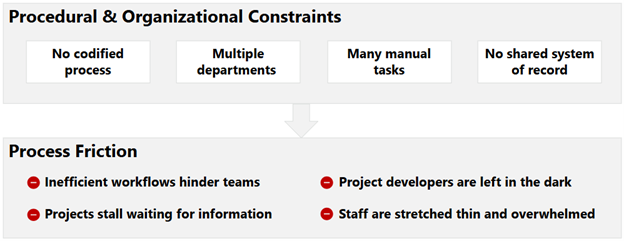This year’s DTECH Data Centers and AI conference made it clear that in the era of AI and data centers, large load requests are hitting utilities faster and at greater scale than ever before.
Policy, pricing, supply chain, and physical infrastructure are well-known constraints holding projects back. An equally critical bottleneck that is gaining more attention is workflow.
The process problem
Utilities are grappling with how they manage the surge in complex, high-stakes projects, including how they handle speculative projects with unclear timelines, funding, or site control. Many utilities rely on institutional knowledge, inconsistent practices, and a jumble of tools like spreadsheets and scattered emails.
This was the backdrop of a session I co-presented with Matthew Robinson, Supervisor of Transmission Planning & Engineering at Arizona Public Service (APS), where we explored how APS is tackling this challenge head-on.

Inside APS: the scale and urgency
APS currently manages over 20,000 MW in large load requests—nearly three times its system peak load. This surge in demand has introduced complexity, requiring coordination across eleven departments and multiple external stakeholders. Previously, the process was hindered by manual tasks, siloed communication, and unclear ownership, making it increasingly unsustainable. APS recognized the need to formalize a more efficient, scalable process and implement a modern software solution to streamline operations and enhance coordination.
But APS had a head start. For years, they have been using PowerClerk® for DER interconnection, FERC Large Generator Interconnection Procedures (LGIP), customer programs, and joint use pole attachment requests. The results have been significant. For instance, with FERC LGIP they have been experiencing:
- 50% faster application reviews—from a week to a couple of days
- Improved transparency for internal teams and developers
- Quick and flexible implementation of FERC Order 2023 requirements
- Reduced risk of penalties and delays
Now, they’re applying the same approach to large load requests by replacing spreadsheets with structure, speed, and scalability.
How PowerClerk helps: no-code workflow automation
PowerClerk streamlines complex, multi-party workflows like large load requests by providing a shared portal with secure role-based access—ensuring each user can view and manage only the project data relevant to their role and stage in the process.
Within the portal, powerful workflow automation orchestrates every step of these complex processes by weaving together business rules, automations, communications, and API integrations, keeping data organized and large load requests moving forward efficiently.
PowerClerk’s data history and flexible reporting helps utilities ensure compliance, monitor performance, and further optimize processes.
PowerClerk’s no-code design lets non-technical users build and adapt their workflows with drag-and-drop simplicity as requirements evolve. This has been key for APS, enabling them to take control of their process and make iterative changes without disrupting in-flight projects.
AI-augmented workflows in action
As utilities face growing scale and process complexity, PowerClerk continues to evolve—releasing 40+ times per year and now integrating AI to unlock new possibilities. AI augments PowerClerk workflows to help users make more informed decisions, automate cognitive tasks, and reduce friction in user experiences. For example, PowerClerk’s AI Attachment Analysis, currently in beta testing, assists in reviewing technical documents like single-line diagrams, a common source of deficient interconnection applications. This is a practical AI-powered feature that helps spot issues earlier, reduce rework, and keep projects on track.
These AI-powered enhancements continue to build on the same trusted platform utilities already use—layering intelligence into workflows without disrupting existing processes.
I’m excited to share more about these AI enhancements in a post coming next month.
Take control with PowerClerk
The DTECH Data Centers and AI conference made it clear: the grid is being asked to stretch in ways it never has before. Workflow bottlenecks are no longer just operational headaches: they’re strategic risks. With PowerClerk, utilities gain control of their processes. Whether it’s large load requests, generator interconnections, transmission service requests, or other complex multi-party processes, PowerClerk enables teams to move faster, collaborate more effectively, and deliver better outcomes.
In an era where speed, scale, and complexity define the new normal, no-code workflow automation software is essential for utilities to stay ahead and serve their customers with confidence.
Contact us to learn about managing large load requests with PowerClerk.
